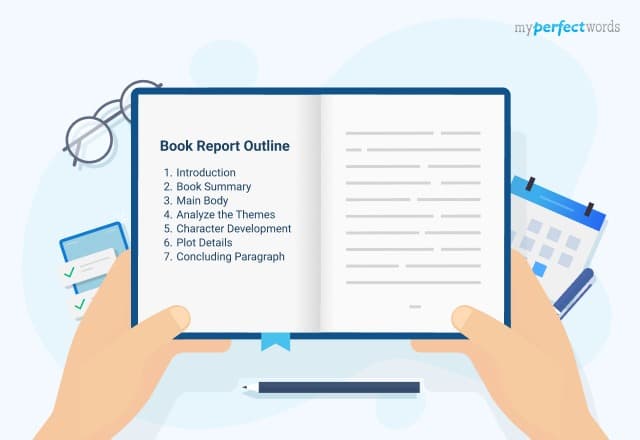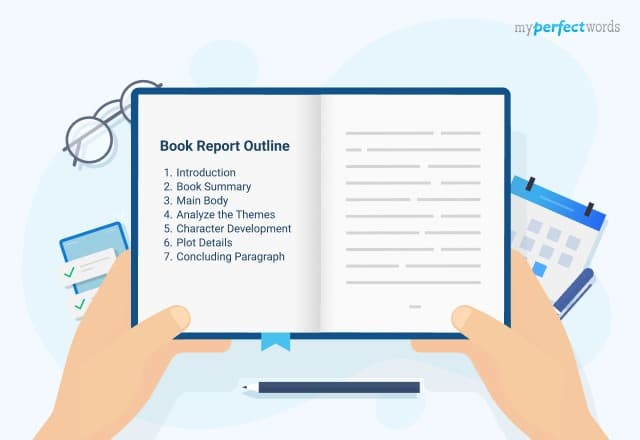

Are you struggling to write a compelling book report that will impress your teacher and earn you that coveted 'A'?
You're not alone.
Many students struggle with the complexities of writing book reports, unsure of where to start and how to structure their reports effectively. The pressure is on to get it right and showcase a deep understanding of the book's content.
But fear not!
In this comprehensive guide, we'll take you through each step of the book report writing process, providing you with the templates, and expert tips you need to create a flawless book report outline.
Let's dive in!
On This Page![]()
- 1. How to Write an Outline for a Book Report?
- 2. Book Report Outline Examples
- 3. Tips for Writing a Book Report
How to Write an Outline for a Book Report?
Creating an outline for your book report is the foundation for a well-structured and organized analysis. It's your roadmap to ensure you cover all the essential elements and present your insights clearly.
Let's break down the process step by step:
Step 1: Start with the Basics
Begin by noting down the fundamental details: the book's title, author, publication date, and any relevant background information about the author or the book's context.
Example: For instance, if you're reviewing "To Kill a Mockingbird" by Harper Lee, you'd include the author's name and a brief mention of the book's setting in the American South during the 1930s.
If you are looking for ideas for your next book report, check out our book report ideas blog!
Step 2: Introduction
A strong introduction is important to avoid boring your instructor and secure higher grades in your book report. A good opening paragraph should include:
- Title of the book
- Author's basic information
- Number of pages
- Year of publication
- Type and genre of the book
- Brief introduction to the book
- Details about the publishing house and publication date
- Any accolades received by the book
- An engaging thesis statement
Moreover, the introduction is an excellent opportunity to captivate the reader's interest by sharing unusual facts about the book or the author.
Every book has a unique backstory and thought process behind it, and your role as a writer is to uncover and explain how these factors shaped the book's narrative.
Step 3: Book Summary
The summary of the book includes a broad overview of the book and its plot. In addition, it details the main theme and story, the point of the narrative, the setting, and the whole story at large.
If you have read the book carefully, you could work on this part of writing the book report process effectively.
Step 4: Main Body
The body should include the main part and important elements of the literary work that you are writing your book report about.
Each paragraph contemplates an idea or main theme and plot that includes:
- The main theme, or themes that you will focus on
- Examples and quotes from the book to emphasize your important points
- Fatal flaws of the main character of the book and its impact on the story and life of other characters
- Commentary on the writing style of the writer
If you read the book carefully, you may come across a number of other themes, make notes of them, and explain them briefly in your book report.
Step 5: Analyze the Themes
Discuss the book's central themes or ideas. What messages or lessons is the author trying to convey?
Example: In the case of "To Kill a Mockingbird," you might explore themes such as racial prejudice, moral growth, and the loss of innocence.
Step 6: Character Development
Analyze how the characters evolve throughout the story. Are there notable changes or developments in their personalities, beliefs, or relationships?
Example: Scout's growth from a naïve child to someone who understands the complexities of her society is a significant aspect of character development in the book.
Step 7: Plot Details
Dig deeper into the plot by providing key details about significant events and major plot twists. Highlight moments that drive the story forward.
Example: In "To Kill a Mockingbird," pivotal plot details include the trial of Tom Robinson and the revelation of Boo Radley's true nature.
Step 8: Concluding Paragraph
In the final section of the book report outline, you bring everything together. This is where you provide a summary of the entire book, present a distinctive critique, and restate your thesis.
Evaluate the book's strengths and weaknesses, share the insights gained from it, discuss its personal impact, and substantiate your observations with examples from the book.
Lastly, provide a brief personal perspective on the book and your recommendation for potential readers.
Step 9: Editing and Revision
The process of writing a book report should be reviewed to ensure its quality. Having someone else review your work will help you identify typos and grammatical errors. This will free up your time to focus on other aspects of the editing process.
Once you are done with your outline, it's time to start writing. Here is a book report template for your understanding:
Essays analyze and argue, while book reports summarize. An essay outline focuses on your main points and evidence, while a book report outline maps the story and key elements.
Book Report Outline Examples
To illustrate the principles of how to make a book report outline, we've compiled a few book report outline sample pdfs. Feel free to use these examples as a starting point for your own book reports.
Here is the third-grade book report outline example for starters:
Book Report Outline for 3rd Grade 1. Introduction Title and author of the book A brief explanation of what the book is about 2. Main Characters List and describe the main characters in the story Include details about their personalities and roles in the book 3. Setting Describe where and when the story takes place Mention any important locations or time periods 4. Plot Summary Give a simple summary of the beginning, middle, and end of the story Highlight the main events that happen in the book 5. My Favorite Part Share your favorite part of the book and why you liked it It could be an exciting moment, a funny scene, or something you found interesting 6. What I Learned Discuss any lessons or new things you learned from the book It could be a moral lesson or new facts about a topic in the book 7. Conclusion Sum up your thoughts on the book Mention whether you would recommend this book to other kids your age |
Here are some more examples for Middle School Book Report Outline:
Need book reports for high school and college? Give a read to these examples:
Tips for Writing a Book Report
Here are some simple steps to write a book report:
- Read the Book Carefully: Pay attention to key details, themes, and characters.
- Take Notes: Jot down important points and quotes while reading.
- Create an Outline: Organize your summary by plotting the beginning, middle, and end of the book.
- Write a Summary: Provide a concise overview of the plot, main characters, and themes.
- Include Analysis: Discuss the author's message and how it is conveyed.
- Use Quotations: Support your points with direct quotes from the book.
- Be Objective: Focus on presenting an unbiased summary rather than personal opinions.
All in all, creating a book report outline is simple, especially with the helpful details we've provided above.
However, if you still need more help writing a book report, feel free to reach out to MyPerfectWords.com.
We have qualified and professional writers who offer exceptional 'write my book report' services. Our experts can craft a custom book report for any book and academic level.
Just visit our website to place your 'Do my essay for me' request and let our professionals handle it!
Frequently Asked Questions
What are the five parts of a book report?
Here are 5 parts of a book report:
- Title and Author: Identify the book's title and author.
- Summary: Provide a brief overview of the plot, main events, and major characters.
- Analysis: Examine themes, motifs, and the author's purpose.
- Personal Response: Share your thoughts, feelings, and personal reflections on the book.
- Conclusion: Summarize your overall impression and state whether you would recommend the book.
What is the difference between book reports vs. book reviews?
A book report is a summary of the book's plot, characters, and main themes, focusing on what the book is about. A book review is an evaluation that includes the reviewer's opinion on the book's quality, strengths, and weaknesses.
How long is a book report?
A book report is typically 250-500 words long, though the length can vary based on the assignment's requirements.

Write Essay Within 60 Seconds!
Use our AI tool to generate high quality essay-18976.png&w=256&q=75&dpl=dpl_Gdsvp7W41w43ZdA5Qu4MrGDa9Trz)
WRITTEN BY
Amanda M.
Columbia journalism grad writing speeches. I craft clear, quotable messages for media moments.


